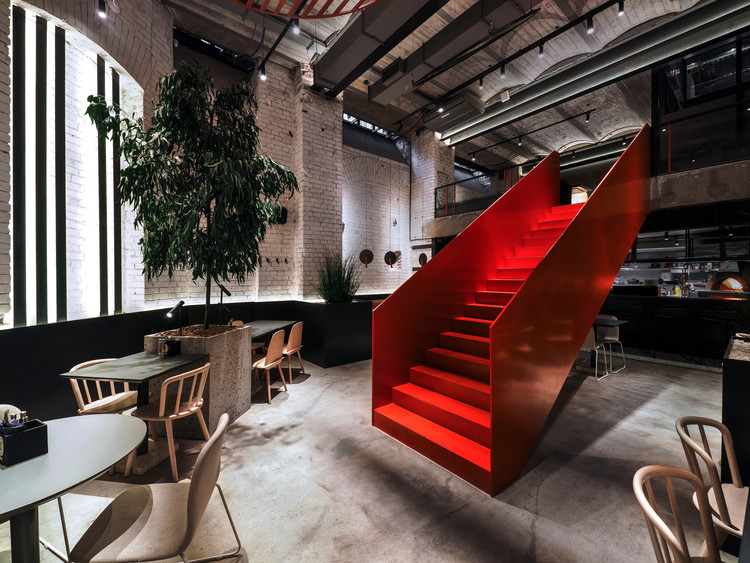Buckner Companies Headquarters Weinstein Friedlein Architects
2011-05-15 00:00
架构师提供的文本描述。新总部的全国起重机租赁和钢安装业务是一个长期考虑更新,一个古老的,家族经营的企业。生意很好,而且还在发展,但现有的空间却很狭窄,安排得很糟糕,而竞争的加剧需要更好的团队合作。业主们把需求变成了机遇。巴克纳公司位于北卡罗莱纳州中部的总部是钢铁组装商贸易的展示场所,是一项关于材料回收和再利用的研究,也是一个典型的协作工作环境。
Text description provided by the architects. The new headquarters for a nationwide crane leasing and steel erection business was a long-contemplated update to a venerable, family-run enterprise. Business was good and growing, but existing space was cramped and poorly arranged, and increasing competition demanded better teamwork. The owners turned need into opportunity. The Buckner Companies’ headquarters in central North Carolina is a showplace for the steel erector’s trade, a study in material salvage and reuse, and a model collaborative work environment.
新建筑的形成围绕着围绕双高空间的概念,项目经理和行政人员的办公室,创造了垂直的,视觉的联系。该项目为巴克纳现有的办公大楼增加了1.5万平方英尺(约合1.5万平方米),并对其进行了全面翻新,以建造咖啡馆、运动场和其他社区空间。这些共用的地方,以及连接新建筑和旧建筑的第二层封闭人行桥,是让所有员工感受到与新建筑连接的关键。
The new building took form around the notion of surrounding a double height space with the offices of project managers and administrative staff, creating vertical, visual connection. The project added 15,000 square feet to Buckner’s existing office building, which was extensively refurbished to make a cafe, exercise area and other community spaces. These shared places, and a second-level enclosed pedestrian bridge linking the new building with the old, are a key to making all employees feel a connection to the new construction.
材料的选择遵循了一种业主驱动的愿望,想要创造一个关于公司工作路线的地方。该地点包括一个吊车场,堆放着几十年来从各个建筑工地救出的建筑部件。设计师梳理了梁,柱,梁,支撑,甲板,甚至旧起重机部件,可以设计成这个项目的“波尼德”。最后,83吨钢件-超过40%的建筑钢材-是直接从巴克纳的院子里运来的。完成的项目包括在其暴露的钢框架中的翻新柱和梁,再使用瓦楞纸金属甲板来支持屋顶和地板,以及打捞弯曲木胶水层合屋顶梁,这些梁被重叠,以创建一个朝南的牧师。就连一座重达15吨的人行桥也会被回收、捡起来,并从巴克纳30年前第一次安装的大学校园搬来搬去。两根15英尺高的前体育馆屋顶梁构成了一个新会议室的墙壁,它的悬臂位于大楼的前部,并遮住了正门,并为总部提供了路标。
Material choices followed an owner-driven desire to make a place that spoke of the company’s line of work. The site included a crane-rigging yard piled with building parts rescued from various construction sites over the decades. Designers combed the “boneyard” for beams, columns, girders, braces, decking and even old crane parts that could be designed into the project. In the end, 83 tons of steel pieces – more than 40% of all the steel in the building – came directly off Buckner’s yard. The completed project includes reconditioned columns and girders in its exposed steel frame, reused corrugated metal deck to support roofs and floors, and salvaged curved wood glue-laminated roof beams, which were overlapped to create a south-facing clerestory. Even a 15-ton pedestrian bridge is recycled, picked up and moved from a college campus where Buckner first put it in place 30 years before. Two pieces of 15-foot tall former coliseum roof girders make the walls of a new conference room, which cantilever’s out the front of the building and shelters the main entrance and provides signage for the headquarters.
在已实现的重复利用现有材料的可能性的推动下,业主的挑战越来越多地支持一个全方位的可持续项目。所采用的绿色建筑措施包括:芯片和焦油驱动、雨水生物保留池、高可循环利用的新材料,如加瓦状屋顶和油毡地板覆盖层,以及包括低流量厕所装置和屋顶排水渠在内的节水措施,为车辆清洗提供了一个15,000加仑的蓄水池。
Fueled by the realized possibilities for reusing existing materials, the owner’s challenge grew to embrace an all-points sustainable project. Green building practices incorporated include a chip-and-tar drive, storm water bioretention pond, new materials with high recycled content such as galvalume roofing and linoleum floor covering, and water conservation measures including low-flow toilet fixtures and roof drains supplying a 15,000-gallon cistern for vehicle washing.
 举报
举报
别默默的看了,快登录帮我评论一下吧!:)
注册
登录
更多评论
相关文章
-

描边风设计中,最容易犯的8种问题分析
2018年走过了四分之一,LOGO设计趋势也清晰了LOGO设计
-

描边风设计中,最容易犯的8种问题分析
2018年走过了四分之一,LOGO设计趋势也清晰了LOGO设计
-

描边风设计中,最容易犯的8种问题分析
2018年走过了四分之一,LOGO设计趋势也清晰了LOGO设计
























































